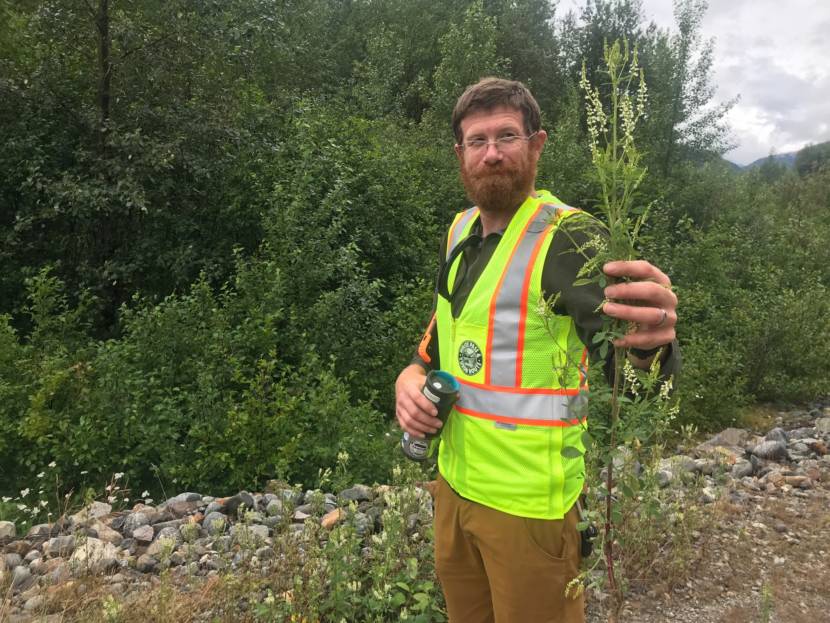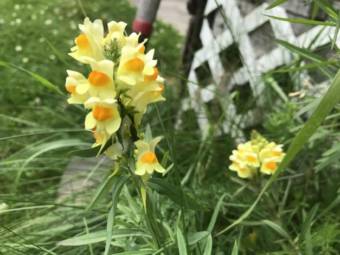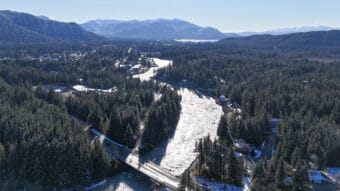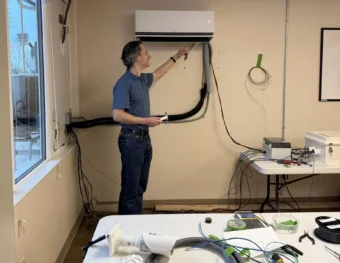
Invasive plants are threatening local ecosystems in Southeast Alaska, and Skagway’s local tribal government is working to stop the spread.
Reuben Cash stood by the White Pass rail yard, a couple of hundred feet from the Skagway River, using a portable computer to map the locations of invasive plant species.
“This is a member of the pea family. It is a Eurasian plant called white sweetclover. As you can see, every little one of these flowering florescences has, you know, five to 100 flowers. And the bigger plants can have up to, I couldn’t even give you a count, but there are probably thousands of seeds produced from every single plant,” Cash said.
Cash works as the environmental coordinator for the Skagway Traditional Council, the local tribal government. Cash and his coworkers have been gathering location data and pulling up plants by the hundreds for the last few summers. The white sweetclover is a delicious-smelling plant, with white flowers that grow in bunches in gravelly patches and distressed soils.
“The pea family is what’s called a pioneer species,” Cash said. “They’re the first ones to move in after like mosses and the lichens really set the stage. They come in and they put nitrogen into the soil, so they make it possible for a plant community to flourish,” Cash said. “It can grow pretty much anywhere you throw it.”
Because it’s a non-native plant, the ecosystem hasn’t designed ways to keep it in check. Cash said if these invasive species are left to their own devices, they will eventually choke out native species.
“Normally in a plant community, you have these plants that are growing side by side with one another. And yeah, they keep each other in check so that nothing grows too abundantly. But with invasive species, there are not those mechanisms built into the community. So they just run rampant,” he said.
White sweetclover isn’t the only plant on the hit list.
“We’re actively watching the reed canary grass invasion over at Pullen Creek and really hitting heavy on the white sweetclover. We’ve been watching out for orange hawkweed. Orange hawkweed has been seen in a couple of different spots around town. And then hopefully, we’ll be rolling out a campaign this year for the yellow toadflax, or butter and eggs, try and get the community on board and see if we can make a dent on it,” Cash said.
Yellow toadflax is a beautiful addition to a bouquet, but it’s a vining plant, and as such it’s very difficult to control once it starts to spread.

“Pretty soon we’ll have nothing but reed canary grass, white sweetclover and yellow toadflax. That’ll just be what’s here. That’s not very good for our pollinators. It’s not very good for all the higher organisms up the food chain that are all relying on the native vegetation here,” Cash said.
Imagine a roadside with all the yarrow and fireweed and lupine replaced by invasive species. It’s a scenario the Skagway Traditional Council has been battling to prevent for the past six years.
According to Cash, without the use of toxic chemical pesticides, the best course of action is to painstakingly pull these plants out of the ground.
“Pull every last one that we can find, and hope that we’ve gotten to it before it’s too late,” Cash said.
He’s also encouraging others in Skagway to join the fight. If people see an invasive species on the list, especially white sweetclover, Cash asks that they log the location with their smartphone.
“Open your Maps app, hit the little crosshair target so that it centers on your position, and then just press and hold on to the screen. It’ll drop a pen and give you the option to share that.”
Then he wants people to email email him the location.


